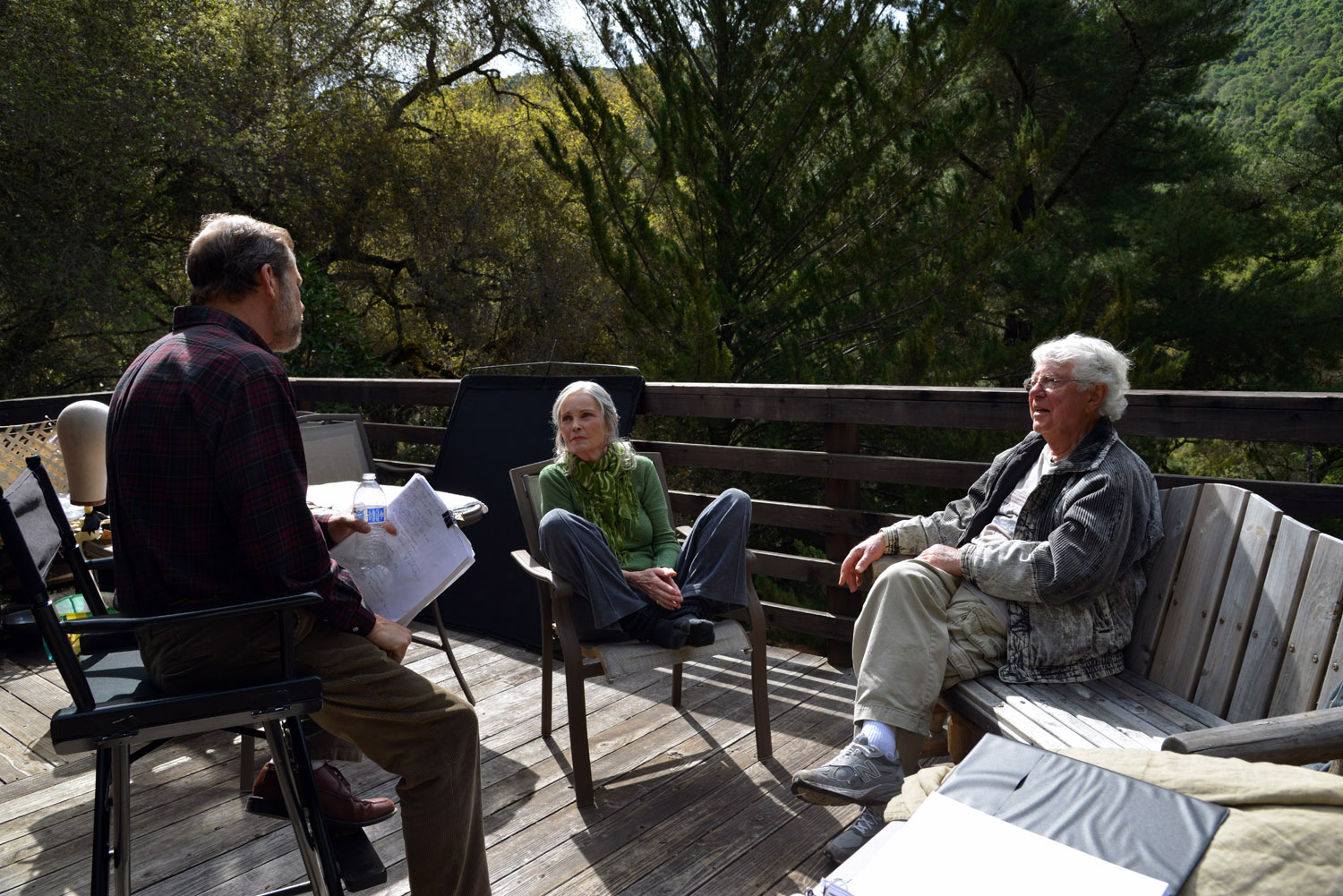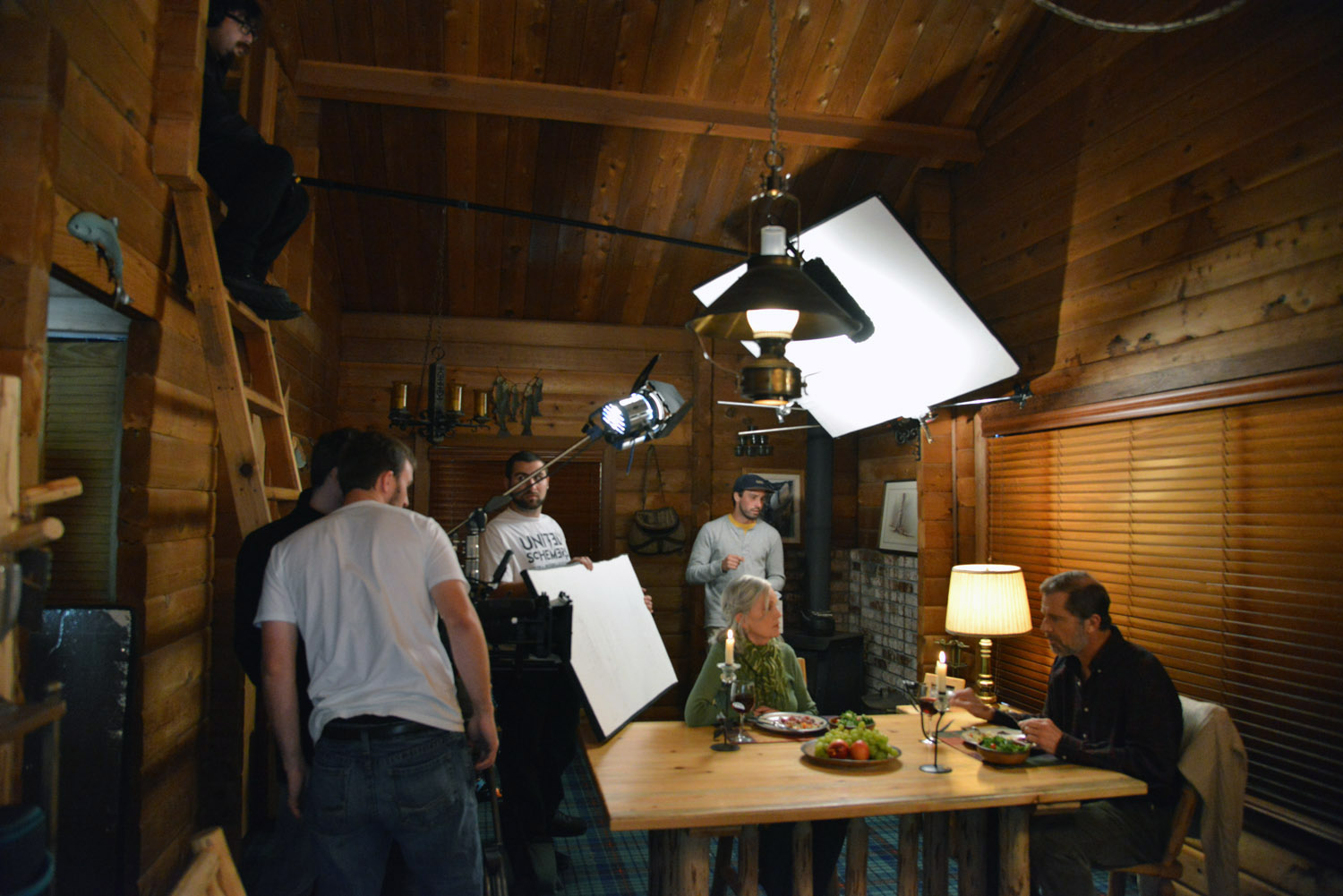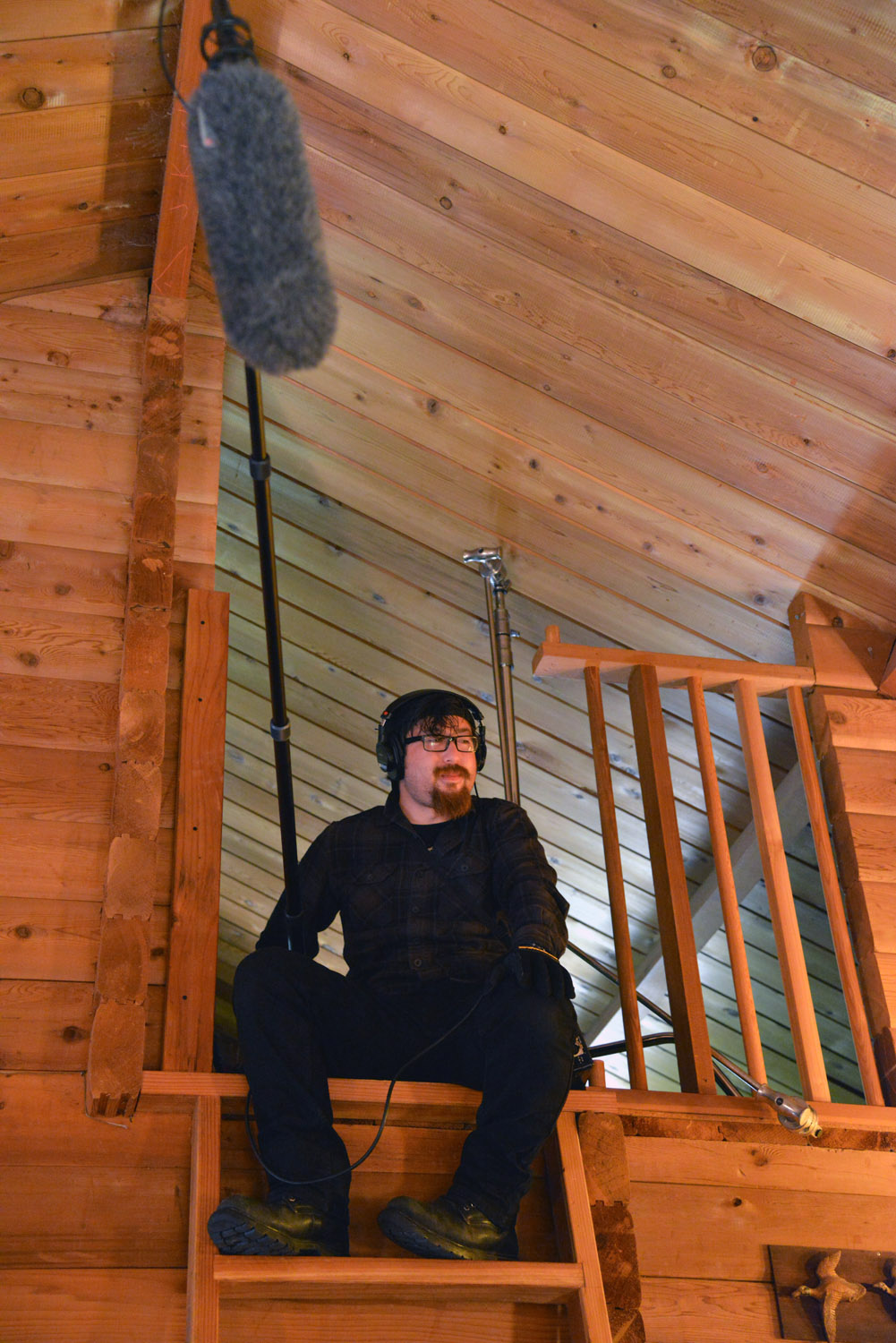FILMED APRIL 2013
Our second day of filming on THE RIGHT REGRETS began the same way as the first day -– the cast and crew met at a parking lot (this time the Safeway’s in mid-Carmel Valley), to be led by Jim Challis in caravan to our White Rock location. Well for me not quite the same. The butterflies in the stomach on my first day behind a movie camera in twenty-six years were gone. I was back in the saddle and raring to roar. The trip as before (I had traveled it twice during location scouting) took about forty-five minutes, although because of the very early morning hour, it was not nearly as beautifully scenic as I remembered, and in the grayness of that early hour, the steep winding road as we neared our destination made me thankful I was in the passenger seat and art director Ryan Gibson was behind the wheel, driving my green Range Rover, which was going to be needed at the location for the filming.
The caravan arrived at the cabin, and the company split into two groups. The camera crew and I were led by Jim Challis the additional twenty-minute ride to the lake to prepare for our first set-up. The rest of the company remained at the cabin, where Shiloh and Jessica, our make-up and hair gals, set up an area on the cabin’s spacious and scenic deck, to do their magical work turning Marlyn Mason and Maxwell Caulfield into Lily McHenry and Charles Wickham.

An added joy for me on this project was my niece, Lisa Lupo, who came up from Los Angeles to be the production designer on THE RIGHT REGRETS. Since I retired just about the time she entered show business, we had never worked together, but more about her later. Accompanying her for the first six days of our shooting schedule was her son, my great-nephew, Julien Silvas. Ten-year old Julien is the lead singer in a rock group, The Hooligans, and has appeared twice at the Roxy Theatre on Sunset Boulevard in West Hollywood. He even managed to make himself useful on our crew.

I have mentioned that my friend, David Potigian, took time away from his art gallery, GALLERY SUR, in Carmel to be our set photographer. He is a professional photography artist specializing in landscapes, and this was a new adventure for him. Because his gallery specializes in photographs of Big Sur and the incredible California coastline, he came with us the first day to the Big Sur Lighthouse and Garripata Beach. His intent was to do it only for that one day, but after that exciting day he was hooked. He remained with us for eight of our nine days of filming, during which time he shot almost 1500 photographs and movie clips. David has an incredible eye for composition, and I was amazed at the stunning results he produced, since everything he shot was candid, none of it was posed.

Meanwhile further up the mountain (I know, it’s not really a mountain, but I choose to think of it that way) we had arrived at the lake, and after Jim left, director of photography Brandon Fraley and I revisited the areas we had selected for our two scheduled sequences. It was a fine day, and as the sun rose higher in the sky, the rays shining through the trees around the lake added to the beauty of what we were about to film. Then Jim suddenly reappeared, and it was not the smiling, exuberant Jim who had so recently departed. He told us the lake and the land around it on which we were standing was privately owned. He had known that but had not anticipated any problem with our filming there, but the owner (or the son of the owner) had seen our group arrive and had contacted Jim and told him we had to leave. Jim was chagrined and embarrassed. We packed up our gear and prepared to return to the cabin, and Jim left to see what could be negotiated that would allow us to return to the lake on a future day. Our arrival at the cabin caused a great deal of surprise. They were expecting the cars to come back to transport the rest of the crew and the two principal actors up to the lake. I was told that Marlyn said, “What the (expletive) is going on?” I announced the change in plans. We could not film at the lake as planned, so we would stay in the area and film the cabin scenes that had been scheduled for the following day. That could create a problem. Even though most actors of the caliber of Marlyn Mason and Maxwell Caulfied will usually learn the lines for the entire script before filming begins, there is an emotional preparation actors make for the scenes they are scheduled to film each day. After giving Brandon the set-up for our first scene, Marlyn, Maxwell and I retired to the cabin deck to rehearse.

Fortunately Marlyn’s hairstyle for our first sequence in the cabin was the same as the one for the first sequence we were scheduled to film at the lake, so she was made up and ready to roll. But in the cabin there were problems. Ryan Wood, our gaffer, was supplying not only the electrical equipment, but also what was needed for the grip department, including a camera dolly and track. Each day, in a small trailer, he would bring to the location only those items that would be needed for the day’s scheduled sequences. Well, he was prepared to film exterior scenes at the lake and was woefully lacking the lamps to film three highly dramatic interior sequences. But there were no complaints. He and director of photography Brandon Frayley went to work and according to my Frayne Williams mantra, they proceeded to sublimate their limitations.

The problems with the change in schedule didn’t end there. We had a scene to film with Marlyn and Maxwell dining, but there was no food. My niece Lisa, who in addition to her duties as production designer had taken on the responsibilities of prop master and wardrobe, took over. While we rehearsed and the crew lit the scene, she sent someone back to the Safeway where earlier that morning we had assembled. But in the meantime, in case they didn’t get back in time for us to use what they bought, she took some of the sandwiches that had been purchased for the crew’s lunch, discarded the buns, used the lettuce for salads and arranged the other ingredients on plates for the entrees. And that was what we filmed
In the meantime Jim Challis had been negotiating with the landowners. He arrived back at the cabin and announced that the father who owned the property and had the final say was waiting outside in his golf cart. He wanted to speak to Marlyn. We were between setups, so Marlyn readily agreed, and as she prepared to leave, she said, “I’ll be back in ten minutes.” She then asked Jim, “How old is this guy?” Jim responded, “In his eighties,” to which Marlyn replied, “Well if I have to sleep with him, it’ll take twenty minutes.” She returned in ten.
I remember the sound booms that we used both at the studio and on location.

But independent productions can’t usually afford such luxuries. And even if we could have, there was no space in that small cabin room for it. In fact there wasn’t even space on the floor for our soundman, Nick Abasolo, so he found a perch from whence he could function in the cabin’s loft…

…which created a strange problem. The microphone at the end of the boom is always suspended above the head of the actor speaking. But somehow in the following scene when we were filming Marlyn’s close-up …
… Nick had the microphone over Maxwell’s head. Now in postproduction we are going to have to rerecord Marlyn’s speeches and lay that sound track into the film.
I keep pointing out the differences and difficulties between film and digital photography. But digital does provide many advantages. Even with the most efficient script person on book, there are times when questions will arise as to matching wardrobe, action or sometimes, even make-up. With a laptop computer on the set, the dailies containing the scene in question can be inserted, viewed, and the question is immediately solved.
 Marlyn Mason, Me, Lisa Lupo, Assistant Director Hope Garza
Marlyn Mason, Me, Lisa Lupo, Assistant Director Hope Garza
At the end of the day, and it was an early ending, because we were not prepared to film the two scenes outside of the cabin, Jim returned with some heartening news. The property owners required him to submit papers proving we were properly insured and other conditions that I’m vague about. There was also going to be a rental fee, which Jim insisted he would take care of – it was his contribution to the production. Since accomplishing this was going to take some time, returning to the lake the following day was not possible. But rain was scheduled for the next day, so we would not have been able to shoot there anyway. We again rearranged our schedule and planned for the third day to go to my friend, Dino’s house (scheduled for the ninth day), planning to return to the lake on the ninth day. Jim was confident the contretemps would be resolved by then.
And so ended our second day, a day with equal portions of drama being enacted before and behind he camera. We were a little behind schedule because of dropping the exterior scenes at the cabin, but I was confident we would easily do them when we returned to film the lake.
My award for the best performance of the day?
 Jim Challis
Jim Challis



This is a classic:
We were between setups, so Marlyn readily agreed, and as she prepared to leave, she said, “I’ll be back in ten minutes.” She then asked Jim, “How old is this guy?” Jim responded, “In his eighties,” to which Marlyn replied, “Well if I have to sleep with him, it’ll take twenty minutes.” She returned in ten.
Dear Sir, Marlyn is my special friend and to many. A real swell person. How I wish my friend and I could have gotten there to be extras. Here in Maryland and Air Fare with no available seats, but very very expensive ones at that time of year. Looking forward to this winning big.We should make Rhode Island. Know how great you are. Thanks. Eva Whiteman
WOW!!!… So awesome reading your reflections on that crazy day!!!… Thank you for not mentioning the icky soup that Max had to endure! LOL.. Can’t wait to read your next installment. LET’s MAKE ANOTHER SOOOOOOOON!!!!…. Stuff is brewing down here in LA!
xoxoxoxoxoxo
P.S. Ryan and I can’t stop laughing at the AMAZING photo of Julien!… PRICELESS!!!!!!!
GOOD!!!!!!!!!!!!
Marlyn, would the 20 minutes have been due diligence for you or ..wishful thinking on the part of the 88 year old?! thanks for the LOL..
I never fail to be floored by behind-the-scenes movie-making stories. Even better when they’re so wittily recounted via the anecdotal mind of the masterful Mr. Senensky! And with pictures and video clips yet! His complete text needs to be an appendage of the DVD/Blu-Ray RIGHT REGRETS supplements!
Knowing how to keep a’goin’ when strange things happen, like losing your location at the last second is a challenge – usually at least one person will panic – but with Ralph at the helm, there’s always a way, and sometimes it works out even better!
I can’t wait to see the results – Ralph, it’s been 33 years since we worked together, and it honestly seems like yesterday.
Brava Marlyn , sei una meravigliosa attrice, il tuo caro amico fan Giuseppe dall’Italia!